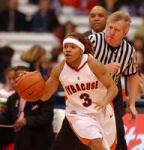Miranda Paul has published more than 50 short stories for magazines and digital markets and is the author of several picture books from imprints of Lerner, Macmillan, and Random House. Her debut, One Plastic Bag: Isatou Ceesay and the Recycling Women of the Gambia, and her second book, Water is Water were both named Junior Library Guild selections. She is a Co-Regional Advisor for the Wisconsin Chapter of SCBWI and the administrator of RateYourStory.org, a site for aspiring writers.

I’ve invited Miranda to our blog to talk about her work with We Need Diverse Books™.
What is your role in WNDB, and how did you get involved?
My official title is VP of Outreach. I got involved at first by chatting on Twitter about diversity issues in literature with several of the individuals who became the force behind WNDB. The conversation moved off of Twitter and collectively, the grassroots team decided to launch a three-day awareness and action campaign. That’s how WNDB got started, really. We were trending days before the official campaign start date, and after the hashtag (#WeNeedDiverseBooks) took the world by storm, BookCon invited us to present in New York. From there, we launched our own website, filed for non-profit status, raised over $300,000 and began implementing several initiatives ranging from awards and grants to internship program and booktalking kits.
What does WNDB hope to accomplish and how?
Our official mission is to advocate essential changes in the publishing industry to produce and promote literature that reflects and honors the lives of all young people. To accomplish this, we recognize all diverse experiences, including (but not limited to) LGBTQIA, people of color, gender diversity, people with disabilities*, and ethnic, cultural, and religious minorities. We have continued a strong social media presence, and in 2015 we’ve expanded our presence on the ground and in communities through attending literary events, distributing kits, and bringing on more team members who live in different geographic areas.
Some of our upcoming goals include a mentorship program, a diversity festival, and more ways in which we can serve readers through helping them discover great diverse books that are already out there. The Walter Dean Myers Awards will recognize some of those books, and the Walter Grants will help new voices emerge.
*We subscribe to a broad definition of disability, which includes but is not limited to physical, sensory, cognitive, intellectual, or developmental disabilities, chronic conditions, and mental illnesses (this may also include addiction). Furthermore, we subscribe to a social model of disability, which presents disability as created by barriers in the social environment, due to lack of equal access, stereotyping, and other forms of marginalization.
What resources does WNDB offer to teachers and librarians?
Our “Where to Find Diverse Books” links page, our Summer Reading Series and our Booktalking Kits come to mind. Our links page is a quick go-to guide when looking for recommendations in particular diverse categories. The Summer Reading Series includes Picture Book, Middle-Grade, and Young Adult titles using a comparative graphic model. Some of the Chapter book & Middle-Grade novels included so far summer are:
The Jumbies by Tracey Baptiste
Gaby, Lost and Found by Angela Cervantes
The Lulu Series by Hilary McKay
The Truth About Twinkie Pie by Kat Yeh
The Undertaking of Lily Chen by Danica Novgorodoff
Unusual Chickens for the Exceptional Poultry Farmer by Kelly Jones
More titles will be posted throughout the summer at: http://weneeddiversebooks.org/summer-reading-series/

Our Booktalking Kits are wonderfully visual, and are being utilized by school and public librarians in addition to booksellers. The #WeNeedDiverseBooks Booktalking Kit is a project that was developed with the American Booksellers Association and School Library Journal. This kit helps teachers, librarians, and booksellers promote non-majority narratives in children’s literature and includes:
PB, MG and YA diverse booklists designed to help shed light on lesser known books that are about diverse characters and/or written by diverse authors
Comparative title suggestions and corresponding comp title shelftalking mini-posters

A We Need Diverse Books sign to create your own WNDB display
The great thing about these Booktalking Kits is that we plan to come out with new ones every year, so it’s a resource that will grow over time. Currently, there are ten Middle Grade titles including (just to name a few) Tim Tingle’s How I Became a Ghost, Zeina Abirached’s A Game for Swallows and Alex Gino’s George. Teachers, librarians, booksellers, and bloggers can request the full kit download at: http://weneeddiversebooks.org/edkit/

How can people get involved?
- First of all, sign up for our newsletter, because that’s where we periodically send out calls for help/volunteers.
- I also urge people to download our Booktalking Kits, which are now available online and share them with their local bookstore owners, librarians, and teachers.
- If you’re part of an organization or business that wants to sponsor or support WNDB in a more significant way, we have a partnership request form and we review those quarterly.
- Consider inviting WNDB to your literature festival, conference, or event as well.
- Our success hinges on the keeping the diversity discussion alive and productive, so keeping WNDB news in the spotlight serves all of us. We’re grateful for the re-tweets, shares, and shout-outs.
- We’re also extremely grateful for continued financial support as we implement our programming. (The “Donate” button is right on our navigation bar at diversebooks.org!)
Jacqueline Houtman is the author of The Reinvention of Edison Thomas (Front Street/Boyds Mills Press 2010) and coauthor, with Walter Naegle and Michael G. Long, of Bayard Rustin: The Invisible Activist (Quaker Press of FGC 2014).
Like this:
Like Loading...













 ventures of the Family Fletcher
ventures of the Family Fletcher






